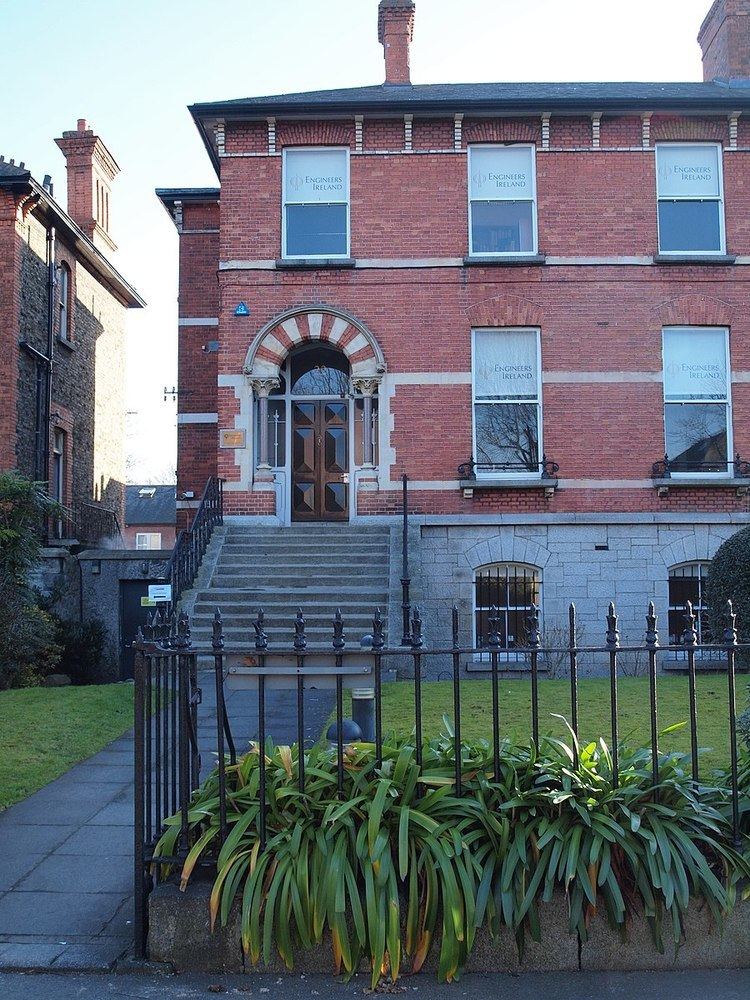 | ||
Founded 1835 as the Civil Engineers Society of Ireland Type engineering society and professional body Focus "The professional body for engineers and engineering in Ireland." Headquarters 22 Clyde Road, Ballsbridge, Dublin 4, Ireland Origins By amalgamation of Cumann na nInnealtóirí into the Institution of Civil Engineers of Ireland | ||
The Institution of Engineers of Ireland (Irish: Cumann na nInnealtóirí) or the IEI, is the second oldest Engineering Society on the islands of Great Britain and Ireland, and was established in 1835, the institution primarily represents members based in Ireland.
Contents
- History
- Mission
- Responsibilities
- Professional Titles
- Sectors
- International
- What the Institution offers
- References
Membership of the institution is open to individuals based on academic and professional background and is separated into grades in accordance with criteria, including the Chartered Engineer and European Engineer titles.
The institution accepted its current legal name in 1969 by an Act of the Oireachtas. In October 2005 the institution adopted the operating name Engineers Ireland in an attempt to reduce any confusion over what the abbreviation IEI means, and as a substitute for its current legal name which is often considered unwieldy; the legal name is, however, unchanged.
History
The history of the institution can be traced to 6 August 1835 when civil engineers met in Dublin; the result was the Civil Engineers Society of Ireland, in 1844 the society adopted the name the Institution of Civil Engineers of Ireland (ICEI). The institution received a Royal Charter on 15 October 1877, this being a significant milestone in obtaining international recognition and standing. In the early years of the Irish Free State Cumann na nInnealtóirí (The Engineers Association) was set up independently, in 1928, by incorporation under the Companies Act, 1908 to "improve and advance the status and remuneration of qualified members of the engineering profession" as it was felt that the institutions charter prevented its negotiation of employment conditions and salary.
As time progressed it was realised that the institution and association might better advance engineering in Ireland by amalgamation of both into a single organisation which would represent a broader set of engineering disciplines, discussions commenced in 1965, and resulted in The Institution of Civil Engineers of Ireland (Charter Amendment) Act, 1969 leading to the redesignation of the unified institution as The Institution of Engineers of Ireland – Cumann na nInnealtóirí. Since this act the institution has represented all branches of engineering in Ireland.
In 1997 the institution set up the Irish Academy of Engineering, based at Bolton Street, Dublin Institute of Technology.
Mission
"The institution promotes the art and science of engineering...", in particular:
"Our members serve society through the highest standards of professional engineering. We seek to improve the quality of life for all, creating prosperity and adding value through innovation and the promotion of health, and sustainable development."Responsibilities
Professional Titles
Sectors
The institution is divided into three sectors; Divisions, Regions, and Societies, which are further subdivided – their purpose is to promote engineering and share knowledge.
International
In accordance with EU requirements it is the designated authority for the engineering profession in Ireland. The institution is a national member of European Federation of National Engineering Associations (FEANI). The institution is also a signator to a number of multilateral agreements, these are principally for registered professional titles and accredited engineering programmes, for academic programmes these are:
The institution is also the signator to a number of bilateral agreements with engineering societies in the United Kingdom. These are for the dual recognition of corressponding Chartered Engineer, Associate Engineer and Engineering Technician grades of the institution.
